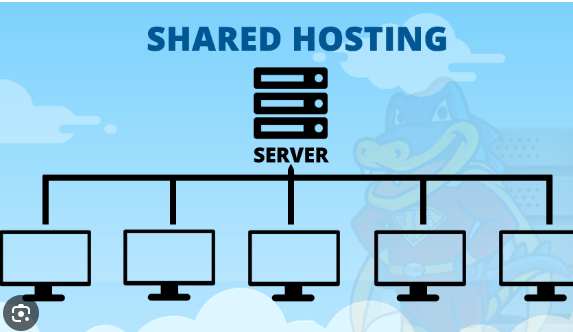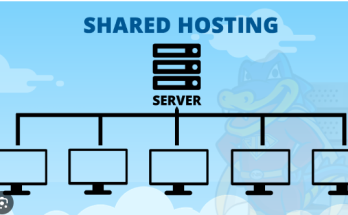Introduction (150-200 words)
Shared hosting is a popular and cost-effective way for individuals and businesses to host their websites. In this comprehensive guide, we’ll delve into the intricacies of shared hosting, exploring its definition, working mechanism, advantages, disadvantages, and considerations before choosing it for your website.
1. Defining Shared Hosting (200-300 words)
Shared hosting involves multiple websites sharing a single physical server and its resources, including CPU, RAM, and disk space. It’s akin to living in an apartment complex where multiple residents share resources like water and electricity. Explain the concept in-depth, highlighting how this differs from other hosting types like VPS (Virtual Private Server) or dedicated hosting.
2. How Shared Hosting Works (300-400 words)
Describe the technical workings of shared hosting—how websites are stored on the server, the allocation of resources, and the role of the hosting provider in managing and maintaining the server. Elaborate on the use of control panels like cPanel or Plesk, which facilitate website management for users.
3. Advantages of Shared Hosting (300-400 words)
Discuss the benefits of shared hosting, such as its affordability, ease of use for beginners, and the maintenance handled by the hosting provider. Highlight how it’s suitable for small to medium-sized websites and businesses with moderate traffic.
4. Drawbacks of Shared Hosting (300-400 words)
Explain the limitations of shared hosting, including potential performance issues due to resource sharing, security concerns, and limited customization options compared to other hosting types. Emphasize how high traffic on one website can impact others sharing the same server.
5. Factors to Consider Before Choosing Shared Hosting (300-400 words)
Provide a checklist of considerations such as the hosting provider’s reputation, server reliability, support quality, scalability options, and the specific needs of your website (e.g., bandwidth, storage, security features).
6. Tips for Optimizing Shared Hosting Performance (200-300 words)
Offer practical advice on optimizing a website hosted on a shared server, including efficient use of resources, caching techniques, content delivery networks (CDNs), and choosing lightweight themes or plugins.
Conclusion (150-200 words)
Summarize the key points discussed, reiterating the benefits and drawbacks of shared hosting. Encourage readers to weigh their website’s needs against the pros and cons discussed to make an informed decision when selecting a hosting solution.
Shared Hosting: Simplifying Website Hosting
In the digital landscape, establishing an online presence is pivotal. Whether you’re an entrepreneur, a hobbyist, or a small business, having a website is key to reaching a broader audience. However, before diving into the intricacies of web development, understanding the fundamental concept of hosting is crucial. Shared hosting stands as one of the most common and accessible options for hosting a website.
1. Understanding Shared Hosting
Shared hosting operates on the principle of resource sharing. Multiple websites are hosted on a single server, sharing its resources like disk space, bandwidth, and other features. It’s akin to renting a space in an apartment building, where each tenant shares the overall resources but has their own designated space.
2. Cost-effectiveness
One of the primary advantages of shared hosting is its affordability. By sharing server resources among numerous users, the cost per user significantly decreases. This makes it an ideal choice for beginners, small businesses, and websites with moderate traffic.
3. Simplicity and Maintenance
Shared hosting providers handle server maintenance, updates, and technical issues. This relieves users from the complexities of server management, allowing them to focus solely on their website content and functionalities.
4. Limitations and Performance
While shared hosting offers cost-effectiveness, it comes with limitations. Sharing resources means that if one website experiences a surge in traffic or consumes more resources, it may affect the performance of other websites on the same server. This can lead to slower loading times or occasional downtime.
5. Customization and Scalability
Shared hosting plans often have limitations on customizations due to shared resources. However, they usually offer scalability options, allowing users to upgrade their plans as their website grows in traffic and complexity.
6. Security Considerations
Security is a shared responsibility in shared hosting. While hosting providers implement basic security measures, vulnerabilities in one website can potentially affect others. Users must take precautions like using secure passwords, keeping software updated, and, if necessary, investing in additional security measures.
7. Choosing the Right Shared Hosting Plan
When opting for shared hosting, it’s essential to consider factors such as uptime guarantees, customer support quality, included features (like email hosting, website builders, etc.), and the provider’s reputation.
Conclusion
In the realm of website hosting, shared hosting serves as an entry point for many website owners due to its affordability and simplicity. Understanding its characteristics, limitations, and potential is vital in making an informed decision regarding hosting your website.
Understanding Shared Hosting for Websites: A Complete Guide
In the vast landscape of web hosting options, shared hosting stands out as one of the most common and cost-effective solutions for hosting a website. This article will delve into the intricacies of shared hosting, offering insights into its definition, advantages, drawbacks, and a step-by-step guide to choose the right shared hosting service for your needs.
What is Shared Hosting?
Shared hosting refers to a web hosting service where multiple websites are hosted on a single physical server, sharing its resources such as CPU, disk space, and bandwidth. Each website on the server has its own partition or space, ensuring separation and security.
Advantages of Shared Hosting:
- Affordability: Shared hosting is budget-friendly, making it an excellent choice for beginners or small businesses with limited resources.
- Ease of Use: Hosting providers handle server maintenance, updates, and security, reducing the technical burden on website owners.
- Scalability: While shared hosting might have limitations in terms of resources, most providers offer scalable plans allowing upgrades as your website grows.
- Technical Support: Quality shared hosting services typically include customer support, assisting users in resolving technical issues promptly.
Drawbacks of Shared Hosting:
- Resource Limitations: Since resources are shared among multiple websites, increased traffic or resource-intensive applications can affect performance.
- Security Risks: Vulnerabilities in one website can potentially affect others on the same server. However, reputable hosting providers implement security measures to mitigate these risks.
- Customization Constraints: Shared hosting often has limitations on server customization, restricting certain configurations or software installations.
Selecting the Best Shared Hosting Service:
- Assess Your Needs: Determine your website’s requirements in terms of traffic, storage, and specific software or applications.
- Research Hosting Providers: Compare different hosting providers based on factors such as reliability, uptime guarantees, customer reviews, and available features.
- Consider Resources and Limitations: Evaluate the offered resources and any limitations on bandwidth, storage, or website applications imposed by the hosting plan.
- Review Support Services: Look for providers offering responsive customer support through various channels like live chat, email, or phone.
- Check Security Measures: Prioritize hosting services that implement robust security measures, including SSL certificates, firewalls, and regular backups.
- Explore Additional Features: Consider additional features like website builders, one-click installations, and email hosting that might be included in the hosting package.
Conclusion:
Shared hosting serves as an entry point for individuals and small businesses seeking an affordable and user-friendly solution to host their websites. While it has its limitations, the right shared hosting service, chosen after careful consideration and assessment of needs, can provide a reliable foundation for your online presence.
In summary, shared hosting offers an accessible starting point for website hosting, balancing affordability with convenience. By understanding its pros, cons, and how to select the most suitable service, individuals and businesses can make informed decisions to effectively establish their online presence.



